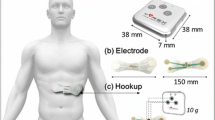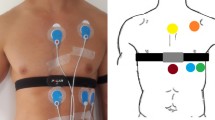Abstract
Heart rate variability (HRV) is an indicator of changes in the interval between successive R-waves on the electrocardiogram (ECG), known as R–R intervals (RRI), caused by autonomic nervous system activity. Measurement of RRI is useful in detecting diseases related to autonomic nervous system activity and predicting seizures. This study proposes an improved heart-rate measurement system that combines a highly accurate, compact, and inexpensive patch-type RRI telemeter with a smartphone application that automatically selects the appropriate measurement position without the need of an expert. To evaluate the measurement accuracy, the RRIs of 10 healthy men and 10 healthy women in supine, sitting, standing, and walking (3 km/h) postures were simultaneously measured using the proposed system and a reference ECG measurement system, and the obtained results were compared. Furthermore, the R-wave detection rate was measured, and Bland–Altman analysis was conducted to analyze the measurement accuracy of the proposed system. The results show that the R-wave detection rate and limit-of-agreement were sufficiently accurate for HRV analysis for 68 and 67 out of the total of 80 epochs, respectively. The fabricated system is expected to enhance the ability of non-experts to conduct ECG measurements and will contribute to improve the quality of healthcare through continuous monitoring at home.











Similar content being viewed by others
Explore related subjects
Discover the latest articles and news from researchers in related subjects, suggested using machine learning.References
Roche F, Gaspoz JM, Minini P, Pichot V, Duverney D, Costes F, Lacour J-R, Barthélémy J-C (1999) Screening of obstructive sleep apnea syndrome by heart rate variability analysis. Circulation 100:1411–1415. https://doi.org/10.1161/01.CIR.100.13.1411
Abe E, Fujiwara K, Hiraoka T, Yamakawa T, Kano M (2016) Drowsiness detection method by integrating heart rate variability analysis and multivariate statistical process control. SICE J Control Meas Syst Integr 9(1):10–17. https://doi.org/10.9746/jcmsi.9.10
Toshitaka Y, Miho M, Fujiwara K et al (2020) Wearable epileptic seizure prediction system with machine-learning-based anomaly detection of heart rate variability. Sensors 20(14):3987–4003. https://doi.org/10.3390/s20143987
Lou Z, Wang L, Jiang K, et al. (2020) Reviews of wearable healthcare systems: materials, devices and system integration. Mater Sci Eng R: Rep 120:100523, 10.106/j.mser.2019.100523
Indra HM, Patrique F, Roland E et al (2021) Pareto optimization for electrodes placement: compromises between electrophysiological and practical aspects. Med Biol Eng Comput 59:431–447. https://doi.org/10.1007/S11517-021—02319-9
Isabel GT, Jose MS, Rui M et al (2016) Design and evaluation of novel textile wearable systems for the surveillance of vital signals. Sensors 16:1573. https://doi.org/10.3390/s16101573
Yasunori T, Yusaku A, Tomonobu S et al (2015) A smart shirt made with conductive ink and conductive foam for the measurement of electrocardiogram signals with unipolar precordial leads. Fibers 3:463–447. https://doi.org/10.3390/fib3040463
Mohamed M, Goran V, Lazar S et al (2017) Multi-purpose ECG telemetry system. BioMed Eng OnLine. https://doi.org/10.1186/S12938-017-0371-6
Ligtenberg A, Kunt M (1983) A robust-digital QRS-detection algorithm for arrhythmia monitoring. Comput Biomed Res 16:273–286. https://doi.org/10.1016/0010-4809(83)90027-7
Salo MA, Huikuri HV, Seppanen T (2001) Ectopic beats in heart rate variability analysis: effects of editing on time and frequency domain measures. Ann Noninvasive Electrocardiol 6(1):5–17. https://doi.org/10.1111/j.1542-474X.2001.tb00080.x
Task Force of the European Society of Cardiology the North American Society of Pacing Electrophysiology (1996) Heart rate variability: standards of measurement, physiological interpretation and clinical use. Circulation 93(5):1043–1065. https://doi.org/10.1161/01.CIR.93.5.1043
Shigeki O, Hiroshi H, Kyouichi M et al (1987) Changes in thoracic potential distribution with respiratory variation (in Japanese). ECG 7(3):295–303. https://doi.org/10.5105/jse.7.295
Acknowledgements
This work was supported in part by JSPS KAKENHI Grant Number 21H03855 and by the research project for medical engineering collaboration and implementation of artificial intelligence from the Japanese Agency for Medical Research and Development (AMED) Grant Number 21445838.
Author information
Authors and Affiliations
Corresponding author
Additional information
Publisher's Note
Springer Nature remains neutral with regard to jurisdictional claims in published maps and institutional affiliations.
This work was presented in part at the joint symposium of the 27th International Symposium on Artificial Life and Robotics, the 7th International Symposium on BioComplexity, and the 5th International Symposium on Swarm Behavior and Bio-Inspired Robotics (Online, January 25-27, 2022).
About this article
Cite this article
Noguchi, A., Takano, T., Fujiwara, K. et al. Interactive system for optimal position selection of a patch-type R–R interval telemeter. Artif Life Robotics 28, 226–235 (2023). https://doi.org/10.1007/s10015-022-00815-1
Received:
Accepted:
Published:
Issue Date:
DOI: https://doi.org/10.1007/s10015-022-00815-1




